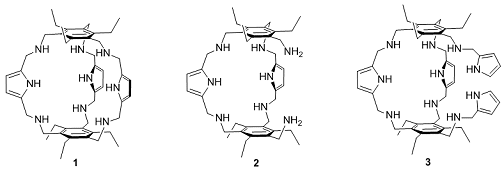Carbohydrates play an essential role in biological systems. They are involved in processes such as cell-to-bacteria and cell-to-virus adhesion, which are governed by selective recognition of specific saccharide epitopes. Understanding these processes at a molecular level is important for the design of new synthetic receptors that can recognize carbohydrates.
Stefano Roelens, Polo Scientifico e Tecnologico, Firenze, Italy, and co-workers have designed a set of structures, based on the tripodal aminopyrrolic cage receptor (1), for the recognition of glucosides. Cleavage of one pillar of the cage (2) improved the binding properties of the receptor, as long as the two residual amino groups remained present. Similarly, replacing one pillar with two aminopyrrolic hydrogen-bonding arms (3) significantly increased the binding ability, despite the loss of a preorganized structure.

These improvements are due to the ability of the flexible structure to establish stronger hydrogen-bonding interactions by more closely matching the binding requirements of the glucosidic guest.
This research is a step forward in the design of synthetic receptors for the recognition of carbohydrates.
- Systematic Dissection of an Aminopyrrolic Cage Receptor for β-Glucopyranosides Reveals the Essentials for Effective Recognition,
Oscar Francesconi, Matteo Gentili, Cristina Nativi, Ana Ardá, F. Javier Cañada, Jesús Jiménez-Barbero, Stefano Roelens,
Chem. Eur. J. 2014.
DOI: 10.1002/chem.201400365




